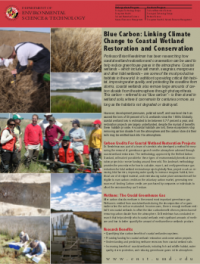| Research Document | Description |
|---|---|
Blue Carbon: Linking Climate Change to Coastal Wetland Restoration and Conservation (Dr. Brian Needelman)Professor Brian Needelman has been researching how coastal wetland restoration and conservation can be used to help reduce greenhouse gases in the atmosphere. Coastal wetlands- which include salt marsh, seagrass, mangroves and other tidal wetlands- are some of the most productive habitats in the world. In addition to providing critical fish habitat, improving water quality, and protecting the coastline from storms, coastal wetlands also remove large amounts of carbon dioxide from the atmosphere through photosynthesis. This carbon- referred to as “blue carbon”- is then stored in wetland soils, where it can remain for centuries or more, as long as the habitat is not degraded or destroyed. |
|
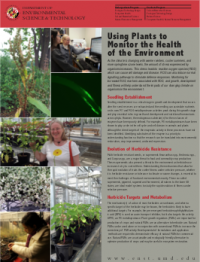 |
Using Plants to Monitor the Health of the Environment (Dr. Wendy Peer)As the climate is changing with warmer winters, cooler summers, and more springtime ozone levels, the amount of stress experienced by organisms increases. This stress leads to reactive oxygen species (ROS) which can cause cell damage and disease. ROS can also induce normal signalling pathways to stimulate defense responses. Monitoring for increased ROS, markers associated with ROS, and growth, development and fitness will help understand the impacts of our changing climate on |
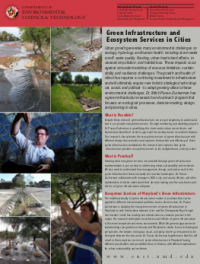 |
Green Infrastructure and Ecosystem Services in Cities Ecosystem Services in Cities (Dr. Mitch Pavao-Zuckerman)Urban growth generates many environmental challenges on ecology, hydrology, and human health, including storm water runoff, water quality, flooding, urban heat island effects, increased air pollution, and habitat loss. These impacts occur against a broader backdrop of resource limitation, sustainability, and resilience challenges. The growth and health of cities thus requires a continuing investment in infrastructure and will ultimately require new holistic strategies technological, social, and political - to adapt growing cities to these environmental challenges. Dr. Mitch Pavao-Zuckerman has a green infrastructure research and outreach program that focuses on ecological processes, decision-making, design, and planning in cities. |
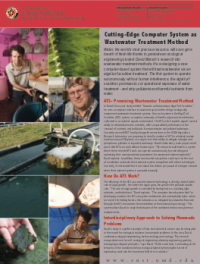 |
Green Infrastructure and Ecosystem Services in Cities (Dr. Patrick Kangas)Water, the world’s most precious resource, will soon get a breath of fresh life thanks to graduate student David Blersch’s research into wastewater treatment methods. An ecological engineering graduate student in the Department of Environmental Science and Technology (ENST), David is designing a new computerbased system that will treat wastewater via an algal turf scrubber treatment. The fi rst system to operate autonomously without human interference, the algal turf scrubber, promises to cut operational expenses of water treatment - and strip pollutants and harmful nutrients from water. |
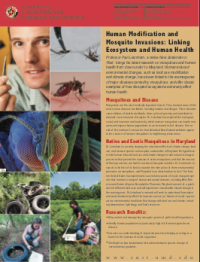 |
Coupled Human-Natural Systems: Linking Ecosystem and Human Health (Dr. Paul Leisnham)Professor Paul Leisnham, a native New Zealander or 'Kiwi', brings his latest research on mosquitoes and human health from 'down under' to Maryland. Human-induced environmental changes, such as land use modification and climate change, have been linked to the reemergence of major diseases carried by mosquitoes, and offer classic examples of how disrupted ecosystems adversely affect human health. |
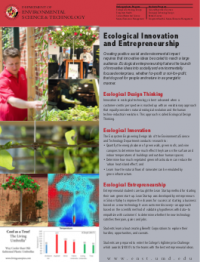 |
Thermal, Hydrological, and Growth Properties of Green Wall Designs (Dr. David Tilley)Covering building exteriors with vegetation has increased in popularity due in part to a desire to conserve energy and improve the environmental performance of buildings. |
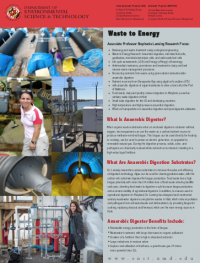 |
Waste to Energy: Bioenergy & Bioprocessing Technology (Dr. Stephanie Lansing & Dr. Amro Hassanein)Professor Stephanie Lansing Research Focus includes: Bioenergy and waste treatment using ecological engineering, Waste to Energy Research: Anaerobic digestion, microbial fuel cells, gasification, microbial electrolysis cells, and solid-oxide fuel cells, Life cycle assessments (LCA) and Energy (eMergy) of bioenergy, Antimicrobial resistance, persistence and treatment in dairy and beef manure waste management processes, Recovering nutrients from waste using post-nutrient extraction after anaerobic digestion, Nutrient recovery from Chesapeake Bay using algal turf scrubber (ATS), with anaerobic digestion of algae feedstocks to drive a fuel cell at the Port of Baltimore, Food waste, dairy and poultry manure digestion in Maryland, as well as sanitary waste digestion in Haiti, Small-scale digesters for the US and developing countries, High temperature and high pressure anaerobic digestion, and Effects of nanoparticles on anaerobic digestion and post-digestion utilization. |
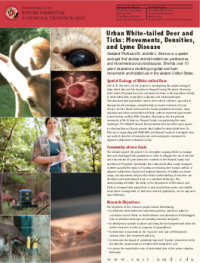 |
Wildlife Communities and Lyme Disease in Suburban and Urban Environments (Dr. Jennifer M. Mullinax)Dr. Jennifer M. Mullinax is a wildlife ecologist that studies animal habitat use, preferences, and movements across landscapes. She has over 20 years of experience modeling different species’ movements and habitat use, including such projects as black bear habitat across the southeast, box turtle movements in D.C., waterfowl movements as they relate to avian influenza, and white-tailed deer and mouse ecology as they relate to tickborne zoonotic diseases |
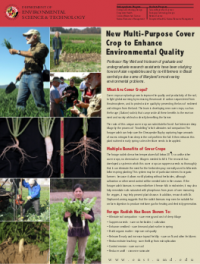 |
Advanced Cover Crop Systems to Build Soil Health, Reduce Nutrient Loss, and Cool the Planet (Dr. Ray Weil)Professor Ray Weil and his team of graduate and undergraduate research assistants have been developing advanced cover crop systems that can help solve some of Maryland’s most vexing environmental problems. |
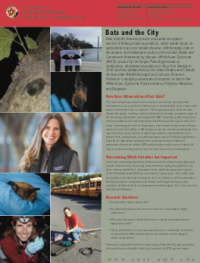 |
Bats and the City (Dr. Shannon P. Browne)Bats in North America provide many valuable ecosystem services such as consuming insect populations, which wreak havoc on agricultural crops and spread disease. Unfortunately, cave bats in most of the United States and Canada are threatened by disease. White-Nose Syndrome (WNS), caused by the fungus Pseudogymnoascus destructans, decimated cave bat populations in New York starting in 2006 and has radiated across the United States and Canada. A Certified Wildlife Biologist® and Lecturer, Shannon P. Browne has been working in the lab studying urbanization’s impacts on bats in the WNS positive states of Virginia, Maryland, and Delaware |
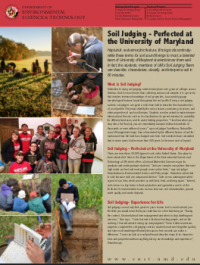 |
Soil Judging (Perfected at the University of Maryland)Hapludult, redoximorphic feature, lithologic discontinuity – while these terms for soil sound foreign to most, a talented team of University of Maryland students know them well. In fact, the students, members of UM's Soil Judging Team, can describe, characterize, classify, and interpret a soil in 60 minutes. |
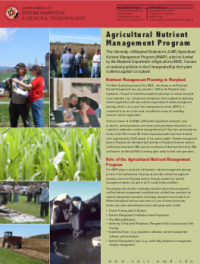 |
Agricultural Nutrient Management Program (Trish Steinhilber)The University of Maryland Extension's (UME) Agricultural Nutrient Management Program (ANMP), which is funded by the Maryland Department of Agriculture (MDA), focuses on reducing pollution in the Chesapeake Bay from plant nutrients applied to cropland. |
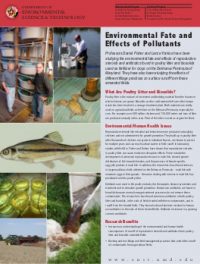 |
Environmental Fate and Effects of Pollutants (Dr. Lance Yonkos)As an Environmental Toxicologist Professor Lance Yonkos integrates fundamental and applied research to better understand and mitigate the sources, fate, and ecological effects of contaminants in the environment. He works primarily within the Chesapeake Bay and similar watersheds with complex mixtures of urban, industrial, suburban, and agricultural landuse. His research addresses three significant fields of inquiry: endocrine disruption, microplastics, and Persistent “legacy” contaminants. |
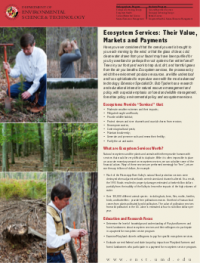 |
Ecosystem Services: Their Value, Markets and Payments (Dr. Bob Tjaden)Have you ever considered that the cereal you eat is brought to you each morning by the wind, or that the glass of clear, cold, clean water drawn from your faucet may have been purified for you by a wetland or perhaps the root system of an entire forest? Trees in your front yard work to trap dust, dirt, and harmful gases from the air you breathe. Ecosystem services, the processes by which the environment produces resources, are little understood and too sophisticated to reproduce even with the most advanced technology. Extension Specialist Dr. Bob Tjaden has a research and educational interest in natural resource management and policy, with a special emphasis on forest and wildlife management, forest tax policy, environmental policy, and ecosystem services. |
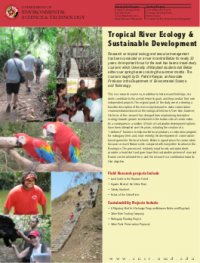 |
Tropical River Ecology & Sustainable Development (Dr. Patrick Kangas)Research on tropical ecology and resource management has been conducted on a river in central Belize for nearly 20 years. An important focus for the work has been a travel-study course in which University of Maryland students visit Belize either over spring break or during the summer months. The course is taught by Dr. Patrick Kangas, an Associate Professor in the Department of Environmental Science and Technology. |
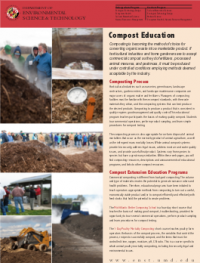 |
Composting Education (Dr. Gary Felton)Composting is becoming the method of choice for converting organic waste into a marketable product. If horticultural industries and home gardeners are to accept commercial compost as they do fertilizers, processed animal manures, and peatmoss, it must be produced under controlled conditions employing methods deemed acceptable by the industry. |
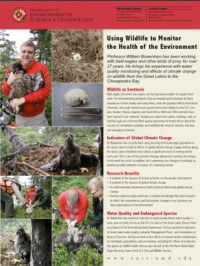 |
Using Wildlife to Monitor the Health of the Environment (Dr. William Bowerman)Professor William Bowerman has been working with bald eagles and other birds of prey, for over 27 years. He brings his experience with water quality monitoring and effects of climate change on wildlife from the Great Lakes to the Chesapeake Bay. |
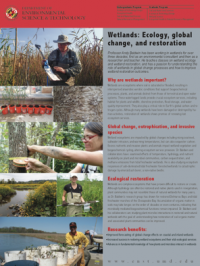 |
Wetlands: Ecology, global change, and restoration (Dr. Andrew Baldwin)Professor Andy Baldwin has been working in wetlands for over three decades, first as an environmental consultant and then as a researcher and teacher. He teaches classes on wetland ecology and wetland restoration, and has a passion for understanding the role of wetlands in global change processes and how to improve wetland restoration outcomes. |
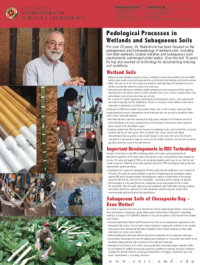 |
Pedological Processes in Wetlands and Subaqueous Soils (Dr. Martin Rabenhorst)For over 35 years, Dr. Rabenhorst has been focused on the pedogenesis and hydropedology of wetland soils, including non-tidal wetlands, coastal marshes and subaqueous soils (permanently submerged under water). Over the last 15 years he has also worked on technology for documenting reducing soil conditions. |
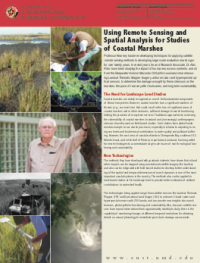 |
Using Remote Sensing and Spatial Analysis for Studies of Coastal Marshes (Dr. Michael Kearney)Professor Kearney has been developing techniques for applying satellite remote sensing methods to developing large scale evaluation marsh vigor for over twenty years. In recent years, he and Research Associate, Dr. Alex Riter, have been studying the impact of hurricanes, excess nutrients, and oil from the Deepwater Horizon Macondo Oil Spill in Louisiana’s marshes us- ing Landsat Thematic Mapper imagery, airborne Lidar and hyperspectral op- tical sensors, to determine the damage wrought by these stressors on the marshes, the pace of recovery after hurricanes, and long term sustainability. |
